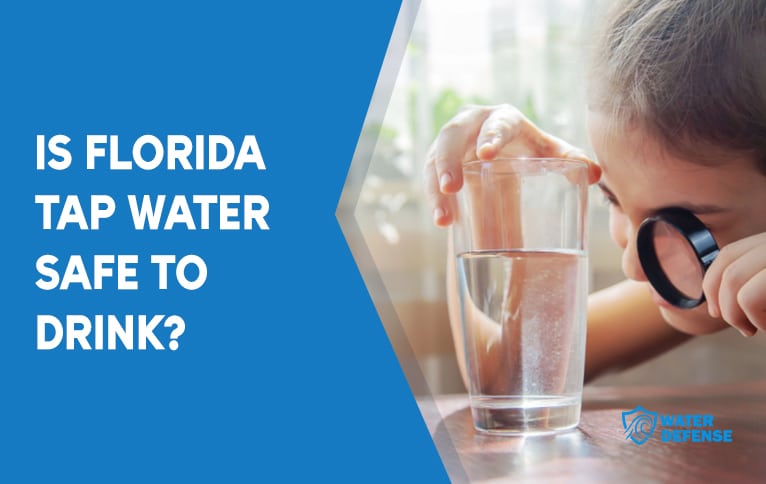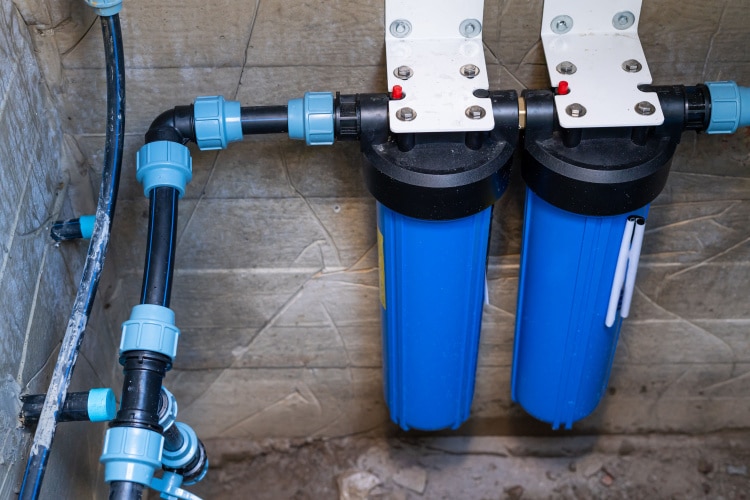Florida is small in acreage, but it’s the third most populated state in the United States, housing more than 27 million people and 411 municipalities. Despite its population density, it’s one of the states with the worst drinking water quality in the country.
90% of tap water in Florida comes from underground aquifers surrounded by limestone with natural filtration capacities. But these natural formations can’t keep everything out as the tap water in Florida keeps getting contaminated.
The state’s soil makeup also makes it easier for surface water to sneak into these aquifers, carrying agricultural chemicals, perfluorinated substances (PFAS), microplastics, and eroding heavy metal deposits. Additionally, phosphate mining and the erosion of natural phosphate deposits produce radionuclides, uranium, and heavy metals such as arsenic and hexavalent chromium, further contaminating the aquifers.

So, although tap water is usually safe in Florida municipalities with effective water treatment facilities (like the big cities of Tampa, Orlando, and Jacksonville), overall, it’s not safe all the time due to the aquifers’ proneness to contamination.
Florida Water Quality Report: What’s in the Water?

Florida is a densely populated state consisting of 267 cities, 123 towns, and 21 villages. Almost all these municipalities have their own drinking water utilities and water treatment facilities. As such, the tap water makeup varies from municipality to municipality.
However, the presence of the following impurities (four heavy metals, two radioactive contaminants, two disinfection byproducts, and perfluorinated substances) is consistent in many municipalities, be it Tampa, Clearwater, Orange County, or Miami.
Lead and Copper
Before the Environmental Protection Agency (EPA) implemented its lead and copper rule in 1991, a rule that prohibits the use of lead and copper components in piping and plumbing systems, these two heavy metals were amply used in pipes, solders, and fixtures. That’s why almost all American municipalities now have lead and copper presence in the water, and Florida is no exception.
In addition, lead leaches into aquifers as a result of mining activities, which adds up to the lead presence in Florida’s tap water. Although the lead action limit set by the EPA is 15 parts per billion (ppb), and many tap water samples from Florida are below that limit, there’s no safe amount of lead in drinking water. So, if you’re worried about these heavy metals, you can purchase a relevant water filter and lay your worries to rest.
Arsenic
Even after the water is treated, there’s still arsenic presence in Florida’s water that reaches up to 7 ppb in some locations, which is among the highest arsenic levels in municipal water in the whole country. This is, for the most part, the result of mining activities, industrial waste, and, on a smaller scale, the erosion of natural deposits.
If you’re concerned, you can check out your area’s latest water quality report on your municipality’s website or purchase a test kit. Should the results show arsenic in your water, it’s best to install a water filter for arsenic removal.
Hexavalent Chromium
Hexavalent chromium, also known as chromium 6 or VI, is another heavy metal found in the tap water all across Florida. It leaks into the water through soil as a result of phosphate mining and improper industrial waste practices.
The EPA doesn’t specifically regulate this particular chromium compound, but there have been many recent studies that connect it to damage to the respiratory tract, various types of cancers, and reproductive issues in males, no matter its levels.
So, our first recommendation is to have your water tested by an EPA-certified lab or purchase an all-round water testing kit. If the results show hexavalent chromium presence in your water, you can invest in a filtration unit that eliminates it.
Radioactive Contaminants
Florida’s geological makeup includes phosphate rocks. Whether mined or unmined, these rocks tend to decay or erode over time. When they do, the small particles eventually find their way into the area’s water table.
However, phosphate isn’t the only element that leaches into the water table. Studies show that phosphate decay or erosion also releases radioactive elements such as radium 226 and 228, thorium, and uranium, and radiochemicals such as alpha emitters.
As a result, many areas in Florida suffer from the presence of radioactive contaminants. Since the EPA health goal set for radioactive contaminants under the National Primary Drinking Water Regulations (NPDWRs) is zero, it’s best to purchase a drinking water filter effective against these hazards.
Disinfection Byproducts
All American municipalities pump chlorine and chloramines into their water systems in order to kill microorganisms and prevent bacterial infestation inside the water lines. However, when these disinfectants come into contact with organic matter, they by-produce other chemicals — namely, total trihalomethanes (TTHMs), haloacetic acids (HAA5), and bromate.
As explained in the EPA’s NPDWRs table we referenced above, all these chemicals carry an increased risk for various types of cancer in the event of long-term exposure.
The disinfection byproduct levels in Florida’s water are lower than the EPA action limit. But the agency also establishes in the NPDWRs’ footnotes that the actual safety limits for these chemicals is zero or close to zero. So, purchasing a relevant water treatment product it still very much worthwhile if you want to ensure your and your family’s safety.
Perfluorinated Substances
Perfluorinated substances, an umbrella term for newly emerging chemical compounds such as PFAS, PFOA, and PFOS, are a new reality we need to face, just like microplastics.
Many industries, from fire fighting to food and beverage packaging, used to utilize them, and nowadays, they are everywhere — in the soil, in the air, in animal and human’ urine and excrement, in fish, and inevitably, in municipal water sources. Florida is no exception.
Although most municipalities’ water treatment plants are equipped to treat them, whether with reverse osmosis or advanced microfiltration technologies, not all the attempts are successful.
Additionally, the EPA doesn’t regulate these substances because the organization thinks that the research on these chemicals isn’t conclusive (as of August, 2023).
Since there’s no getting rid of these substances in the near future and since early studies show links to cholesterol problems, preeclampsia, and increased risk of cancer, it’s a good idea to install a PFAS filter.
Water Hardness
The water hardness in Florida changes from municipality to municipality, but overall, Floridians get hard water from their taps.
Water hardness refers to the calcium and magnesium content in the water. According to the United States Geological Survey (USGS), water that has more than 60 mg/L (parts per million) of these minerals is hard water.
There are only a handful of Floridian municipalities where the water is softer than 60 mg/L: Gainesville (24 mg/L) and Pompano Beach (25.5 mg/L).
Municipalities like Tampa, West Palm, and Jacksonville are on the other side of the scale, with hardness levels that reach up to more than 300 mg/L. Considering the USGS classifies water with more than 180 mg/L calcium and magnesium as extremely hard water, the residents of these municipalities definitely have to deal with the adverse effects of hard water.
What are these effects? Well, hard water doesn’t pose any health risks, but it leaves stains on surfaces, kitchenware, and laundry, leads to mineral buildup in pipes and appliances, and causes dry skin and dull hair.
So, if you reside in a hard water area in Florida, you might benefit from a water softener.
Where Does the Tap Water Come From in Florida?
As stated earlier, 90% of the tap water in Florida comes from underground aquifers. The rest comes from surface water sources, like lakes and rivers. The Floridan aquifers are surrounded by limestone that has natural water filtration capacities.
However, Florida is one of the most crowded states in the United States, and there are about 130 million tourists visiting its beaches almost every year.
So the state is now faced with a new problem, maybe one even worse than the contamination of its underground water reservoirs with phosphate mining and industrial waste practices: water shortage.
The Floridan aquifers can no longer meet the demands of all the residents and tourists. Even worse, the Florida Department of Environmental Protection projects an increase in population, tourist circulation, and subsequently, water demands.
Under the light of these projections, the state has started seeking alternative water supplies, like the ocean, and constructed a desalination plant on Tampa Bay. A desalination plant removes the salt and contaminants from the ocean water and makes it suitable for human consumption.
One of the biggest desalination plants in the United States, the Tampa Bay Seawater Desalination Plant produces 25 million gallons of water on a daily basis. However, that number pales against the state’s daily water consumption of 1.6 billion gallons.
How Is Tap Water Treated in Florida?

Different Floridian municipalities have different water treatment plants for treating groundwater. While the specifics of these plants vary in terms of size, the technologies they employ, and the efficiency of their technologies and filters, the main process is the same as other municipalities in the United States:
- Coagulation, flocculation, and sedimentation: First, a chemical called coagulant is introduced to the water held in a large storage unit. This chemical binds contaminants that have small particles together in flocs. As flocs have more weight than contaminants that move solo, they start to sink to the bottom as sediment, which makes the water at the top cleaner and easier to separate.
- Filtration: Different plants utilize different technologies. These technologies might be reverse osmosis, carbon media, or microfilters. The water that gets separated from the sediment is subjected to these filters for further treatment.
- Disinfection: Before distributing the water to citizens’ households, the municipality would disinfect it. Chlorine, chloramines, and ozone are the most common disinfectants used at this stage.
Desalination plants like the Tampa Bay Seawater Desalination Plant employ a similar process. However, desalinating seawater requires a more robust reverse osmosis technology, so with a desalination plant, this process is slower and more expensive than with a regular water treatment plant.
For more information regarding municipal water in the United States, you can head to our tap water guide.
Does Florida Have the Cleanest Tap Water?
No, Florida doesn’t have the cleanest tap water. Although big cities within the state have state-of-the-art treatment plants, the water quality in Florida is not great.
The aquifers in the state, which supply 90% of the state’s tap water, are contaminated due to phosphate mining and erosion of natural deposits. Most water treatment plants in the state are not robust enough to completely eliminate all the hazards that are present in the water because of this contamination: heavy metals (lead, arsenic, hexavalent chromium) and radioactive elements (radium, thorium, uranium).
In addition, as in many other American municipalities, the disinfectants (chlorine and chloramines) they employ by-produce dangerous chemicals: TTHMs, HAA5, and bromate.
Lastly, the water treatment plants in Florida don’t seem to be effective against PFAS, as almost all the municipalities’ water quality reports show PFAS presence in varying degrees.
Conclusion
Florida is one of the states with the worst tap water quality in the United States. The state depends on underground aquifers for its water supply, but due to the region’s geological makeup, erosion of natural deposits, and mining practices, these aquifers keep getting contaminated.
The most common contaminants that emerge as a result of this contamination are heavy metals and radioactive elements. Additionally, water quality reports show the presence of disinfection byproducts in every municipality of Florida alongside perfluorinated substances.
What’s even worse, these aquifers make up 90% of the state’s water supply and are about to dry, so Florida is threatened by a water shortage crisis. Hopefully, the state’s attempts to implement alternative water solutions, like desalination, can provide long-term relief in the coming years.